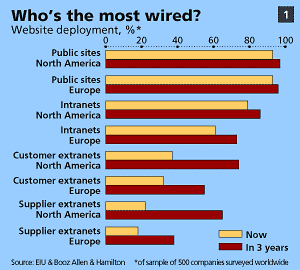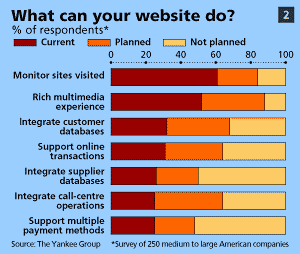 |
SURVEY BUSINESS AND THE INTERNET
The net imperative |
|||||||||
|
Within a few years, the Internet will
turn business upside down. Be prepared—or die, says Matthew Symonds
The Internet is said to be both over-hyped and undervalued. Ask any signed-up member of the “digirati”, and you will be told that the Internet is the most transforming invention in human history. It has the capacity to change everything—the way we work, the way we learn and play, even, maybe, the way we sleep or have sex. What is more, it is doing so at far greater speed than the other great disruptive technologies of the 20th century, such as electricity, the telephone and the car. |
|||||||||
|
|||||||||
| Yet, nearly five years since the Internet developed mass-market potential with the
invention of a simple-to-use browser for surfing the World Wide Web, it is easy to
overstate its effect on the daily lives of ordinary people. Even in the United States, the
most wired country in the world, most people still lack, or choose not to have, Internet
access. And even for most of those who have access both at home and in the office, the
Internet has proved more of an addition to their lives—sometimes useful, sometimes
entertaining, often frustrating—than a genuine transformation. Everybody loves e-mail; if you are a teenage girl, chat is cool; and the ability to retrieve information about so many things is truly miraculous, even if search engines are a bit clunky. Despite early misgivings about credit-card security, buying certain kinds of things on the web—for example, books, CDs and personal computers—is convenient and economical, and has become popular. All these things are certainly nice to have, but they could hardly be called revolutionary. But while the media have concentrated on just a few aspects of the web—the
glamorous consumer side of content and shopping on the one hand, and the seamy end of
pornography and extremist rantings on the other—something much more important is
happening behind the scenes: e-business. The Internet is turning business upside down and
inside out. It is fundamentally changing the way companies operate, whether in high-tech
or metal-bashing. This goes far beyond buying and selling over the Internet, or
e-commerce, and deep into the processes and culture of an enterprise. |
|||||||||
| From e-commerce to e-business | |||||||||
| Some companies are using the
Internet to make direct connections with their customers for the first time. Others are
using secure Internet connections to intensify relations with some of their trading
partners, and using the Internet’s reach and ubiquity to request quotes or sell off
perishable stocks of goods or services by auction. Entirely new companies and business
models are emerging in industries ranging from chemicals to road haulage to bring together
buyers and sellers in super-efficient new electronic marketplaces. The Internet is helping companies to lower costs dramatically across their supply and demand chains, take their customer service into a different league, enter new markets, create additional revenue streams and redefine their business relationships. What Mr Grove was really saying was that if in five years’ time a company is not using the Internet to do some or all of these things, it will be destroyed by competitors who are. |
|||||||||
|
|||||||||
| Most senior managers no longer need convincing. A recent worldwide survey of 500 large
companies carried out jointly by the Economist Intelligence Unit (a sister company of The
Economist) and Booz Allen and Hamilton, a consultancy, found that more than 90% of top
managers believe the Internet will transform or have a big impact on the global
marketplace by 2001. That message is endorsed by Forrester Research, a fashionable high-tech consultancy. It argues that e-business in America is about to reach a threshold from which it will accelerate into “hyper-growth”. Inter-company trade of goods over the Internet, it forecasts, will double every year over the next five years, surging from $43 billion last year to $1.3 trillion in 2003. If the value of services exchanged or booked online were included as well, the figures would be more staggering still. That makes Forrester’s forecasts of business-to-consumer e-commerce over the same period—a rise from $8 billion to $108 billion—look positively modest. There are two explanations: business-to-business spending in the economy is far larger than consumer spending, and businesses are more willing and able than individuals to use the Internet. Forrester expects Britain and Germany to go into the same hyper-growth stage of e-business about two years after America, with Japan, France and Italy a further two years behind. And just as countries will move into e-business hyper-growth at different times, so too will whole industries. For example, computing and electronics embraced the Internet early and will therefore reach critical mass earlier than the rest. Aerospace, telecoms and cars are not far behind. Other conditions for early take-off include the ready availability of the right kind of software, computing platforms and systems-integration expertise. Just as crucial is the impact of so-called “network effects” as online business moves from a handful of evangelising companies with strong market clout, such as Cisco Systems, General Electric, Dell, Ford and Visa, to myriad suppliers and customers. As both buyers and sellers reduce their costs and increase their efficiency by investing in the capacity to do business on the Internet, it is in their interest to persuade more and more of their business partners to do the same, thus creating a self-reinforcing circle. However, even within particular industries companies are moving at different speeds. Much depends on the competition they are exposed to, both from fast-moving traditional rivals and from Internet-based newcomers. But nobody can afford to be complacent. Successful new e-businesses can emerge from nowhere. Recent experience suggests it takes little more than two years for such a start-up to formulate an innovative business idea, establish a web presence and begin to dominate its chosen sector. By then it may be too late for slow-moving traditional businesses to respond. For evidence of how far most companies still have to go in developing their Internet strategies, look no further than their corporate websites. A few pioneers—such as Charles Schwab in stockbroking and Dell in the PC business—have successfully transferred many of their core activities to the web, and some others may be trying their hand at a few web transactions, with an eye on developing their site as an extra distribution channel later. But more often than not, those websites are stodgily designed billboards, known in the business as “brochureware”, which do little more than provide customers and suppliers with some fairly basic information about the company and its products. Most managers know perfectly well that they have to do better. The Yankee Group, another technology consultancy, earlier this year questioned 250 large and medium-sized American companies across a broad range of industries about their views on e-business, and found that 58% of corporate decision makers considered the web to be important or very important to their business strategy. Only 13% thought it not important at all. A large majority (83%) named “building brand awareness” and “providing marketing information” as key tasks for their websites, and almost as many (77%) thought the web was important for generating revenue. A smaller majority (57%) also saw its potential for cutting costs in sales and customer support. Yet despite all this positive talk, three-quarters did not yet have websites that would support online transactions or tie in with their customer databases and those of their suppliers, although many were working on it. In other words, most bosses know what they should be doing, but have not yet got around
to it. It is easy to understand why. Knowing that you need a coherent e-business strategy
is one thing, getting one is altogether more difficult. And until you decide precisely
what your strategy should be, it will not be clear what kind of IT
infrastructure investments you will need to make. |
|||||||||
| Here we go again | |||||||||
| All this gives many managers a
terrible sense of d�j� vu. They have been through outsourcing, downsizing and
re-engineering. They may well have undergone the frequently nightmarish experience of
putting in the packaged information-technology (IT) applications
that automate internal processes and manage supply chains, known collectively as
“enterprise resource planning” (ERP), and are still
wondering whether it was worth spending all those millions of dollars. Nearly all of them
embraced the low cost and flexibility of PC-based so-called
client/server computing at the start of the 1990s, only to discover the perils of
decentralising data and distributing complexity. And over the past couple of years, they
have invested lots of time and money into nothing more exciting than the hope of avoiding
a systems meltdown on the first day of the new millennium. So they have reason to be wary of consultants and visionaries who promise new paradigms and tidal-wave technology. A recent survey of chief executives’ attitudes to IT conducted by the London School of Economics for Compass America found that only 25% believed that it had made a significant contribution to the bottom line, and more than 80% had been disappointed by its contribution to their company’s competitiveness. No wonder many of them are asking themselves whether e-business is the most exciting opportunity or the most terrifying challenge they have ever faced. Yet most of them know that the Internet is in an entirely different category from the technology-driven changes they have either embraced or had thrust on them in the past. The same survey suggested that the Internet has significantly changed expectations about what IT could deliver, with more than half of the top managers saying they had high expectations for the future. Part of the explanation is that IT investments, particularly ERP, have been inward-looking, concentrating on making each enterprise more efficient in isolation. By contrast, the Internet is all about communicating, connecting and transacting with the outside world. With e-business, the benefits come not just from speeding up and automating a company’s own internal processes but from its ability to spread the efficiency gains to the business systems of its suppliers and customers. The ability to collaborate with others may be just as much of a competitive advantage as the ability to deploy the technology. Certainly the technology matters, but getting the business strategy right matters even more. And that may mean not just re-engineering your company, but reinventing it.
|
|||||||||

